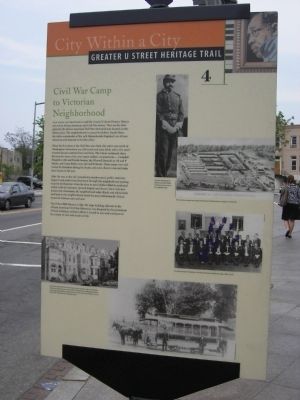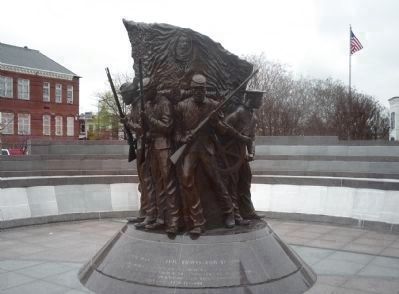U Street Corridor in Northwest Washington in Washington, District of Columbia — The American Northeast (Mid-Atlantic)
Civil War Camp to Victorian Neighborhood
City within a City
— Greater U Street Heritage Trail —
Inscription.
The Shaw neighborhood and the Greater U Street Historic District are rich in African American and Civil War history. They are the ideal place for the African American Civil War Memorial now located on this Metro plaza. The neighborhood was named for Robert Gould Shaw, the White commander of the 54th Massachusetts Regiment, an African American unit featured in the film Glory.
When the first shots of the Civil War were fired, this entire area north of Washington’s downtown was still woods and open fields, with a few small wooden houses scattered here and there. The Union command chose this area for some of the city’s major encampments–Campbell Hospital at 6th and Florida Avenue, the Wisewell Barracks at 7th and P Streets, and Camp Barker near 13th and R Streets. These camps were safe havens for freedmen fleeing the South, and some chose to stay and make their homes in the area.
After the war, as the city’s population mushroomed, public streetcars began to run north from downtown through this neighborhood, opening it up for development. From the 1870s to 1900, builders filled its residential streets with the Italianate, Second Empire and Queen Anne style row houses that characterize the neighborhood today. Blacks and White built and lived in this neighborhood which became predominantly African American between 1900 and 1920.
The Prince Hall Masonic Lodge, the large building adjacent to the African American Civil War Memorial, was designed by the prominent African American architect Albert I. Cassell in 1922 and continues to be a center of civic and social activity.
Erected by Cultural Tourism DC. (Marker Number 4.)
Topics and series. This historical marker is listed in these topic lists: African Americans • Railroads & Streetcars • Settlements & Settlers • War, US Civil. In addition, it is included in the Greater U Street Heritage Trail series list. A significant historical year for this entry is 1900.
Location. Marker has been reported missing. It was located near 38° 55.015′ N, 77° 1.559′ W. Marker was in Northwest Washington in Washington, District of Columbia. It was in U Street Corridor. Marker was at the intersection of U Street Northwest and 10th Street Northwest, on the right when traveling east on U Street Northwest. Marker is on the sidewalk just north of the subway entrance (escalator) for the U Street/African-American Civil War Memorial Metro rail station. Touch for map. Marker was in this post office area: Washington DC 20001, United States of America. Touch for directions.
Other nearby markers. At least 8 other markers are within walking distance of this location. African American Civil War Memorial (a few steps from this marker); Most Worshipful Prince Hall Grand Lodge of the District of Columbia
(a few steps from this marker); a different marker also named African American Civil War Memorial (within shouting distance of this marker); "We had everything we needed right here." (about 300 feet away, measured in a direct line); Evans-Tibbs House (about 300 feet away); New Negro Alliance's Sanitary Grocery Protest Site (about 300 feet away); Industrial Bank of Washington (about 500 feet away); Howard University Sets the Standard (about 500 feet away). Touch for a list and map of all markers in Northwest Washington.
More about this marker. [Photo captions:]
Christian Fleetwood, an African American Medal of Honor winner lived in this neighborhood.
This Civil War [Campbell] Hospital once stood near 6th and Florida Avenue in today’s LeDroit Park.
An archival photo of members of the Prince Hall Grand Masonic Lodge, 1000 U Street.
Conductors pose with their horse-drawn public streetcar, right, on Boundary Avenue, now Florida Avenue, in the 1860s. The advent of public transportation encouraged the building of rowhouses in the area after the Civil War, such as these in the 1900 block of 13th Street, above.
Additional keywords. U. S. Colored Troops, USCT
Credits. This page was last revised on January 30, 2023. It was originally submitted on December 30, 2008, by Richard E. Miller of Oxon Hill, Maryland. This page has been viewed 2,299 times since then and 23 times this year. Last updated on March 7, 2019, by Devry Becker Jones of Washington, District of Columbia. Photos: 1. submitted on December 30, 2008, by Richard E. Miller of Oxon Hill, Maryland. 2. submitted on October 17, 2011, by Richard E. Miller of Oxon Hill, Maryland. • Bill Pfingsten was the editor who published this page.
Editor’s want-list for this marker. A photo of the marker's reverse side. • A wide shot of the marker in context. • Can you help?

